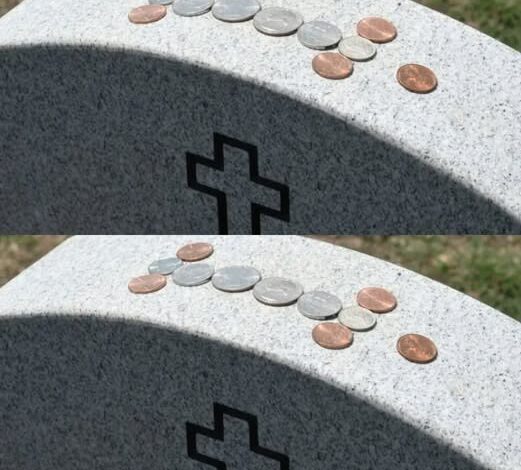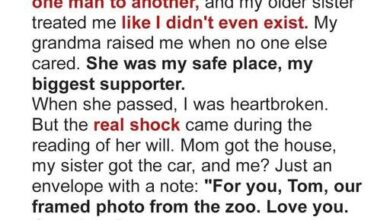
Meaning Behind the Tradition of Coins on Gravestones
If you’ve ever strolled through a cemetery on a quiet morning or at sunset, you may have noticed a small glint of metal resting atop a gravestone. At first glance, it looks like someone simply left loose change behind—a penny, a nickel, a dime, maybe even a quarter. But these small coins are far from random. Each carries a meaning that goes beyond its face value. They are messages of remembrance, tokens of respect, and silent promises that the person buried beneath that stone has not been forgotten.
The tradition of leaving coins on the graves of fallen soldiers has become an enduring custom in the United States, passed along quietly through generations of veterans and their loved ones. It may seem like a small gesture, but in the world of military service, where loyalty and sacrifice define lives, a coin is more than currency—it is a language of remembrance. Every denomination tells a different story, a way of marking the relationship between the visitor and the deceased. Together, they form a code of grief, honor, and unspoken solidarity.
Why coins, though? Flowers fade. Notes can blow away in the wind. Trinkets may not withstand the weather. But coins endure. They are simple, sturdy, universal, and recognizable. Anyone who passes by knows that a coin left on a gravestone isn’t there by accident. It’s deliberate. And once you understand what each coin means, every small piece of metal takes on a weight far heavier than its size.
The penny is perhaps the most common coin left behind. On its own, it carries the most straightforward message: someone was here. A penny says, “You are remembered. Your life mattered.” It might not seem like much, but to a grieving parent, child, or sibling, that small copper coin can mean the world. It confirms that strangers, comrades, or friends continue to carry the memory of their loved one. It whispers that even years after the burial, their sacrifice still resonates.
A nickel carries more significance. It means the person who left it trained with the fallen soldier, often during boot camp. Anyone who has gone through that experience knows that it forges unbreakable bonds. Grueling mornings, relentless drills, and the shared struggle to endure transform strangers into brothers and sisters-in-arms. Leaving a nickel is like saying, “We started this journey side by side, and I still carry those memories with me.”
A dime goes a step further. It tells the family and the world that the visitor served directly alongside the deceased. They may have stood shoulder to shoulder in combat, shared long nights during deployment, or protected each other in moments of danger. A dime is intimate. It says, “I was there with you. I fought beside you. I carry the same scars, and I will never forget.”
And then there is the quarter—the most profound of all the coins. A quarter means the person who left it was there at the time of death. They were present in the soldier’s final moments, whether on the battlefield, in a hospital, or even holding a hand as the last breath was taken. That quarter represents not just memory, but witness. It is a way of saying, “I was with you when it mattered most, and I will carry that moment with me forever.”
This tradition, though deeply tied to military culture, is not widely known outside those circles. For families who stumble upon these coins without understanding, learning their meaning often brings both tears and comfort. It assures them that their loved one’s service continues to be recognized long after official ceremonies have ended. It reminds them that strangers still visit, still honor, still remember. For parents, spouses, and children, those coins are proof that their grief is shared and their loss acknowledged.
Walk through a veterans’ cemetery, and you may find gravestones dotted with coins—sometimes a single penny, sometimes a scattering of nickels and dimes, sometimes an entire collection representing decades of visits. Each one is a thread in a tapestry of remembrance. Together, they create a mosaic of loyalty and honor. In some cases, families even choose to collect the coins left behind, keeping them as sacred mementos that tell the story of ongoing love and respect.
The practice also underscores the lifelong bonds formed in military service. For veterans, leaving a coin is not just about honoring the dead—it’s about fulfilling an unspoken oath to never forget those who sacrificed everything. It’s a continuation of camaraderie that doesn’t end with death. Even after years, a single coin placed on a gravestone reaffirms that connection. It is a ritual of belonging, a way of saying, “You’re still one of us.”
What makes this tradition powerful is that it speaks without words. It doesn’t matter what background you come from, what language you speak, or what politics you hold. A coin on a gravestone cuts through all of that. It’s an act of respect that transcends boundaries. Whether on Memorial Day, Veterans Day, or a quiet weekday afternoon, each coin says the same thing: You are not forgotten.
There’s also something humbling about the simplicity of the act. A coin doesn’t cost much. It’s ordinary. But placed with intention, it becomes extraordinary. It becomes a symbol of sacrifice, service, and memory. That is the paradox at the heart of this ritual: something so small carries a meaning so immense.
Next time you find yourself wandering through a cemetery, pause if you see a coin resting quietly on a headstone. Take a moment to reflect on what it represents. It’s not just spare change left behind by chance. It’s a story still being told. A life still being honored. A bond that even death could not break.
In the end, these coins remind us that remembrance doesn’t have to be grand or elaborate. Sometimes, the simplest gesture—a penny, a dime, a quarter—can hold the weight of love, loyalty, and legacy. And in that silence, we find something profound: proof that sacrifice is never forgotten, and memory is never lost. One coin at a time, the stories of those who served live on.




